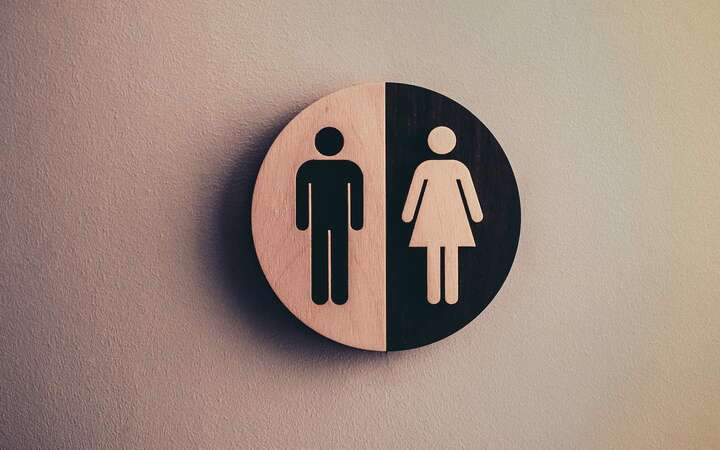The Myers-Briggs Personality Indicator (MBTI) gets a lot of scorn:
About 2 million people take it annually, at the behest of corporate HR departments, colleges, and even government agencies. The company that produces and markets the test makes around $20 million off it each year.
The only problem? The test is completely meaningless.
I began to read through the evidence, and I found that the MBTI is about as useful as a polygraph for detecting lies. One researcher even called it an “act of irresponsible armchair philosophy.” When it comes to accuracy, if you put a horoscope on one end and a heart monitor on the other, the MBTI falls about halfway in between.
Some psychologists believe that independent, peer-reviewed research in the decades since the MBTI was devised has provided something better than Myers-Briggs. They champion the notion of the “Big Five” personality traits — openness, conscientiousness, extroversion, agreeableness and neuroticism.
the MBTI gives a ridiculously limited and simplified view of human personality, which is a very complex and tricky concept to pin down and study. The scientific study of personality is indeed a valid discipline, and there are many personality tests that seemingly hold up to scientific scrutiny (thus far). It just appears that MBTI isn’t one of them.
Nothing personal: The questionable Myers-Briggs test (The Guardian)
It would seem that the the MBTI is nonsense, but the Big Five is a real, scientifically valid test. To be sure, there’s nothing wrong with the Big Five. But these haughty claims that it’s dramatically better than the MBTI have got to end.
Claims Against the MBTI
MYERS AND BRIGGS JUST, LIKE, MADE IT UP
It’s true. Myers and Briggs were enthusiasts of Carl Jung’s theories who created the test during WWII. They hoped to aid the entry of women into the workforce. They weren’t professional scientists and didn’t base it on some large corpus of data. And Jung’s theories are… controversial today.
THERE AREN’T 16 DISCRETE TYPES OF PEOPLE
Also true! There is no switch in your brain set to T or F. We will probably never find the “judging” gene. These traits are probably heritable — everything is — but polygenic. So we should expect varying strengths even if we disregard “nurture” influences.
This complaint is understandable. Some early MBTI proponents really did defend binary outcomes, claiming each attribute was “theoretically dichotomous”. There was even some now-debunked research that claimed to prove that empirically. It’s now clear that the population has a standard bell-shaped distribution for each trait. For example, this is a histogram of the E-I axis (other axes look similar):
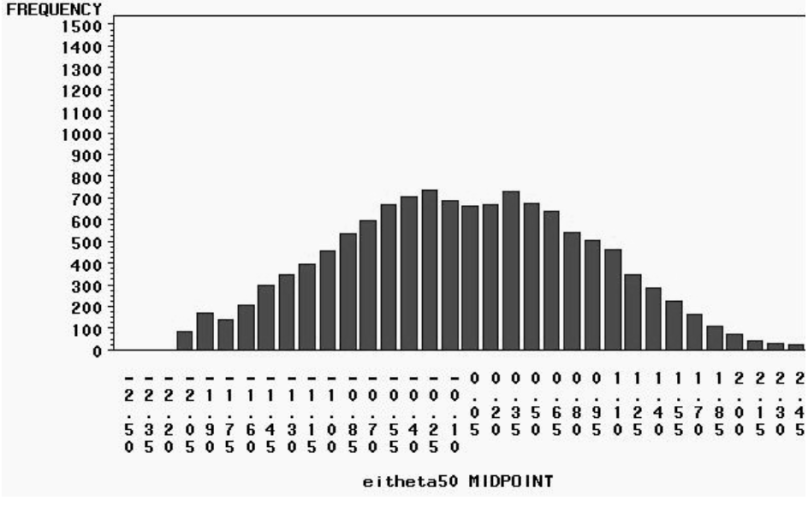
This is from Bimodal Score Distributions and the Myers–Briggs Type Indicator: Fact or Artifact? (Answer: Artifact)
THE MBTI HAS POOR REPEATABILITY
Technically true. Suppose someone takes the test, then repeats it 4-5 weeks later. Something like 35-50% of people will fall into a different one of the 16 groups. Is that bad? We’ll come back to this.
THE MBTI DOESN’T VARY BETWEEN PEOPLE
Not true. This is claimed strangely often with no evidence. Remember that histogram above for introversion vs. extroversion? There’s plenty of variability. All the other axes are similar. Since no one really provides any evidence for this claim, there’s not much to rebut here.
If we’re being very generous, perhaps we could interpret this as a complaint that the population mean for each trait is around zero. That’s true, but again, it varies plenty.
THE MBTI MAKES EVERYONE SEEM LIKE A BEAUTIFUL SPECIAL SNOWFLAKE
I think this is true. It’s hard to read the Big Five and conclude that neuroticism is a positive thing. But every MBTI type seems wonderful in its own way.
THE MBTI MEASURES THINGS THAT AREN’T FUNDAMENTAL or THE MBTI ISN’T USED BY REAL SCIENTISTS or MY IN-GROUP SAYS I MUST TREAT IT WITH CONTEMPT
Well, maybe.
The Myers-Briggs foundation grasps at an image of scientific seriousness in a way that’s a little ridiculous. It grates on me, and I’m not a psychologist. People should probably stop spending money on the official test. People should definitely stop paying $2,500 to get certified to administer that test.
In defense of the MBTI
YOU DON’T HAVE TO BINARIZE THE AXES
90% of the complaints about MBTI come down to: you can’t split people into two groups along these axes! Yeah, OK, then how about we don’t do that?
Of course someone can be borderline. Most people are borderline along at least one axis. Early versions of the MBTI actually gave an “x” for someone near the middle. Let’s bring this back! In fact, let’s go further.
Behold: Dynomight™ MBTI notation:
- Strong preference: Capital letter
- Weak preference: Lower-case letter
- Borderline: x
For example: eNxJ is:
- weakly extroverted (e)
- strongly intuitive (N)
- borderline thinking / feeling (x)
- strongly judging (J)
This gives five bins for each axis. You can still sort of say it out loud by making the strong preferences louder. This gives 5⁴=625 possible results. Of course, there aren’t 625 discrete types of people either. Our goal isn’t to split people into groups, it’s to give a convenient summary of how they answered a bunch of questions.
To underline this point, I even created a Myers-Briggs quiz you can take in 2 minutes that gives results in this form.
To claim it’s never useful to discretize denies human nature. You might as well claim we shouldn’t say “hot” or “cold” but must always give a number of degrees.
IF YOU DON’T LIKE BINARIZATION THEN DON’T
If you’d like a test that gives the scores as continuous attributes, may I recommend… any test? For example, here’s the results of me randomly clicking answers on two popular websites:
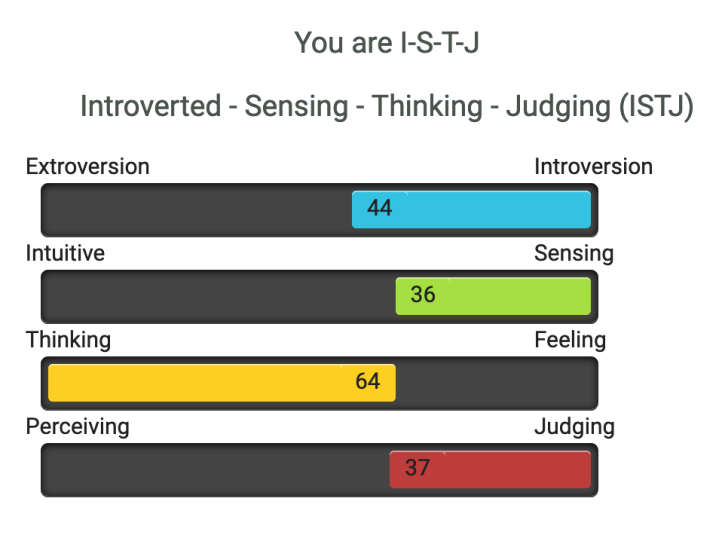
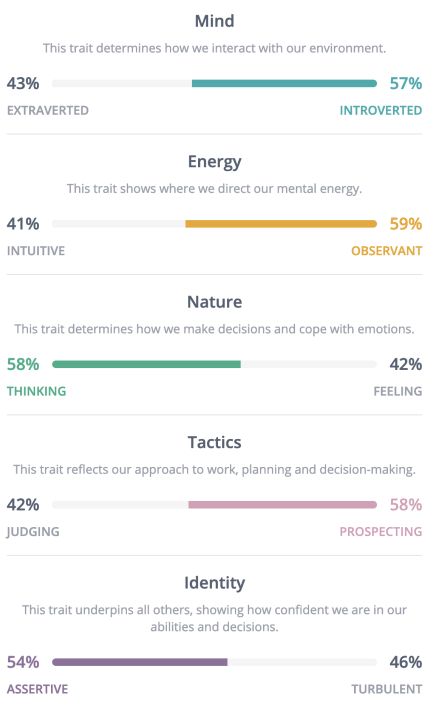
Not convinced? You can even check the “official” results that gullible people pay money for. They look like this:

THE MBTI MIGHT AS WELL BE CALLED THE “BIG FOUR”
And what happens if you don’t discretize the axes? If you take continuous measurements (like every Myers-Briggs test ever gives you) they correlate strongly with four of the five big five measurements.
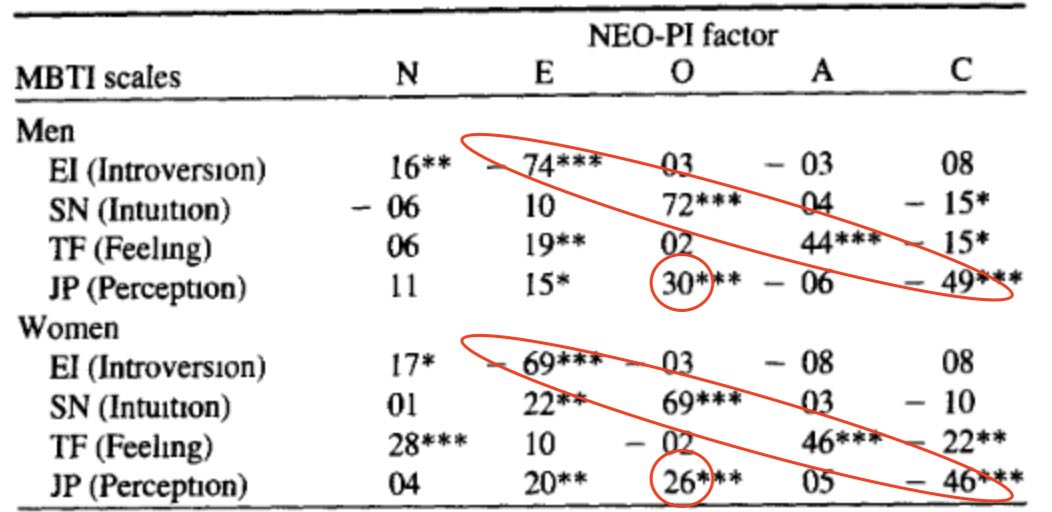
The rows show the four MBTI axes, while the columns show the Big Five axes. This shows that:
- The MBTI E-I axis is strongly correlated with the Big Five extraversion axis. (duh)
- The MBTI S-N axis is strongly correlated with the Big Five openness axis.
- The MBTI T-F axis is moderately correlated with the Big Five agreeableness axis and weakly correlated with the conscientiousness axis.
- The MBTI J-P axis is moderately correlated with the conscientiousness axis and weakly correlated with the openness axis.
To interpret these numbers, note that 74/69 is what you get when the axis is exactly the same thing with exactly the same name. These correlations are strong.
But don’t blame all the journalists for not knowing about this. After all this groundbreaking research is hot off the presses having only been published in 1989. Other research supports the same basic conclusion.
What does this mean? If you believe the MBTI is meaningless, fine. But you must also therefore believe the Big Five is meaningless!
THE MBTI’S REPEATABILITY IS FINE
If someone is near the middle, a small change can land them on the other side. This is why 35-50% of people fall into a different one of the 16 buckets when they re-test. The most common score for all axes is near the middle. There are 4 different axes. If some small measurement noise puts you over the middle on any axis, then you fall into a different bucket.
Since we aren’t binarizing the axes, this is not something to worry about. Instead, we should just ask: How repeatable are the continuous measurements? For reference, here’s Cronbach’s alpha for the Big Five, measured for an Arabic version. Higher numbers indicate better repeatability.
| Trait | Men | Women |
|---|---|---|
| Neuroticism | .83 | .74 |
| Extroversion | .82 | .83 |
| Openness | .79 | .85 |
| Agreeableness | .82 | .81 |
| Conscientiousness | .90 | .92 |
And here’s the results for Myers Briggs:
| Trait | Men | Women |
|---|---|---|
| EI | .82 | .83 |
| SN | .83 | .85 |
| TF | .82 | .80 |
| JP | .87 | .86 |
YOU CAN ADD AN AXIS IF YOU WANT
The Big Five measures neuroticism, while the MBTI does not. This is, no doubt, a very important trait. Some MBTI variants add extra axes. For example, one can introduce an axis that measures turbulence vs. assertiveness. This is a measure of neuroticism in all but name.
Why go with the MBTI?
Everything above just says the MBTI isn’t much worse than the Big Five. So why not just use the Big Five? Well, you just try it.
THE MBTI IS COMFORTABLE TO TALK ABOUT
Say you’re on a first date. You discuss your favorite Italian films, the pets you had growing up. Then, you ask How agreeable are you? How does that go?
If that seems cherry-picked, let’s go through all the attributes:
- How extroverted are you? This is fine.
- How neurotic are you? Uncomfortable.
- How agreeable are you? Uncomfortable.
- How conscientious are you? Somewhat uncomfortable.
- How open are you to experience? This seems fine, but isn’t.
Only one of the five is OK. And — as you surely noticed— that same attribute exists in the MBTI.
Can I tell you a secret? The MBTI’s names for the S-N axes are sensing and intuition. These don’t make any sense. The Big Five openness to experience is much more descriptive. And yet, I claim, the MBTI names are often better because they are meaningless. Everyone claims to be open! But since no one has any idea what “sensing” is, they’ll happily admit to it. Deliberate or accidental, this subterfuge is extremely useful.
For similar reasons, the MBTI’s omission of neuroticism is sometimes good. The alternative to four axes is often zero, not five.
The advantage of the the MBTI is precisely that it makes everyone feel like a beautiful snowflake. The axes are chosen and named ingeniously so as to make them easy to reveal.
THE MBTI IS POSSIBLE TO TALK ABOUT
Binarization is the key criticism of the MBTI. Still, we must confront the fact that binarization is a huge driver of the MBTI’s success. How do we reconcile this?
Say you’re a weirdo who is happy to tell your date your Big Five. How do you actually say it out loud? In fact, I am such a weirdo, and I end up saying something like “My neuroticism is low, my conscientiousness is high, my extroversion is moderate, and… ummm, what are the other axes?”
A big part of what makes the MBTI easier to talk about is that it has names for both ends of the axes. With the MBTI, you have the option of a coarse summary by saying something like “ESFP”. It’s at least possible! Of course, more precise measurements are better, but having options is a positive thing.
I think that we could also sort of make this work with my suggested notation by modulating the sound of your voice. (If you get eNxJ, you say “I’m an e en ex jay”).
Summary
You don’t have to discretize the MBTI axes. The MBTI measures similar stuff as the Big Five with similar repeatability, but it is more appealing and dramatically easier to talk about. Don’t feel guilty about using it.
In theory the Big Five could adopt the advantages of the MBTI by doing two things. (Not that I’m advising this!) First, create names for the axes that sound more neutral, so that people are happy to discuss them. Second, create different names for different ends of the axes, so that an easy optional discretization is possible. But honestly, why bother? If you did that, you’d have basically invented the MBTI.












